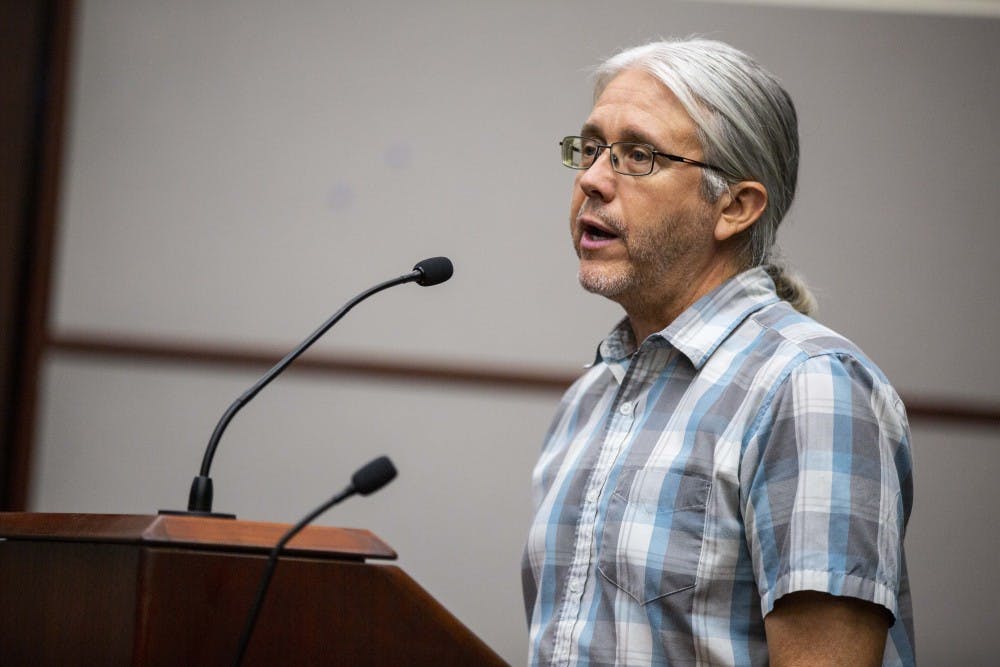The city council passed amendments and conducted final votes Wednesday evening for a parking update and local deer hunt at Griffy Lake Nature Preserve.
Parking
City council unanimously passed a comprehensive update to the city’s parking system Wednesday evening that includes less free parking and increased fees. These changes were first presented to the public Sept. 12.
Most changes will take effect January 2019, but some wait until August.
Studies from Desman Design Management and the Bloomington Parking Commission deemed the city’s parking operations inefficient. Fee increases, extended enforcement times, zone adjustments and management centralization will restructure a system with aspects that hasn’t been updated in ten years.
“Parking will make more sense now in the community,” said council member Andy Ruff.
The council passed eight amendments, including one to preserve parking permit eligibility for sorority and fraternity houses. The original legislation would have eliminated city parking permits for sorority and fraternity houses while maintaining 100 permits for Collins Center.
“It was too draconian a change,” city council member Stephen Volan said.
The amount of available city parking permits for sororities, fraternities and Collins will decrease. The numbers allocated to each house were based on current usage data and ownership of other parking, Volan said.
Like the original elimination proposal, the permit reductions are an effort to provide more spaces for employees downtown.
The amendment also implements a fee increase from $25 to $103 for the Greek housing and Collins permits.
The houses are multi-family dwellings, and the parking spaces would otherwise be used by employees paying $103 for a permit.
The council voted to pass the amended ordinance, but emphasized a need to evaluate its effects, especially for low-income citizens.
“We are by no means done with it,” council President Dorothy Granger said.
Deer cull
City council voted 8-1 to allow a regulated hunt at the Griffy Lake Nature Preserve for deer population control.
The request comes from the Bloomington Parks and Recreation Department for the sake of maintaining biodiversity at the preserve.
The city will contract with White Buffalo Inc. to oversee the hunt. City staff will work alongside the deer management organization to recruit, vet and train hunters, said Paula McDevitt, administrator for the Parks and Recreation Department.
The hunt will be scheduled for three weekends in November and December, and an evaluation will be conducted in December and early January.
A cull performed by a White Buffalo Inc. sharpshooter in 2017 killed 62 deer and cost the city $43,500. The legislation will allow the city to take advantage of the Community Hunting Access Program through the Indiana Department of Natural Resources, which will provide a $32,500 grant for regulated local hunts over the next two years.
Research has shown deer browsing damages biodiversity at the preserve. Steve Cotter, natural resources manager for the Bloomington Parks and Recreation Department, said five to six per square mile deer for the nearly two square mile preserve is an appropriate amount for an ecosystem that’s been damaged for so long.
The current deer population is not known.
Council President Dorothy Granger proposed an amendment that would effectively block this year’s hunt by postponing it until the Parks and Recreation Department presents a count of deer, IU commits to innovative collaboration and an evaluation of data since the December 2017 cull is released. It failed 8-1.
The amendment’s request for a written commitment from IU for innovative collaboration is unlikely, council member Isabel Piedmont-Smith said.
“This is not only a stall tactic,” Piedmont-Smith said.”This is a way to kill the whole idea.”
Some possible methodologies for collecting a deer count could include helicopter counts and cameras to extrapolate populations, Cotter said.
Officials and community advocates say the effects evidenced on the plants is sufficient to warrant deer removal. Council member Dave Rollo, who sat on the Deer Task Force for two years, said deer population counts are not a practice that is used in ecological restoration. Standard practice is evaluating plants.

“The count doesn’t really tell us what we need to know,” Cotter said. “The plant data tells us what we need to know.”
A group of residents presented the council with a powerpoint of 17 reasons opposing the legislation. The lack of population data was a large component.
Some people simply don’t want deer to die, said council member Allison Chopra. If the cull this year was postponed, protests would resurface the next time a deer hunt is considered.
Council members and those in the audience were eager to put the issue to rest. All council members but Granger voted in favor of the ordinance.
“I don’t really want to lose the progress, ecologically, that we’ve gained in the past,” said council member Jim Sims.
A previous version of this story said five to six total deer is an appropriate amount for an entire ecosystem instead of per square mile. The IDS regrets this error.




